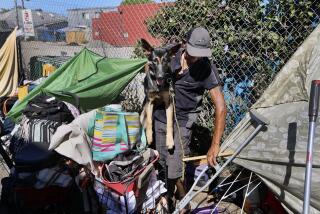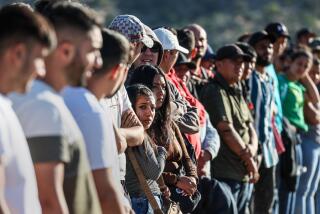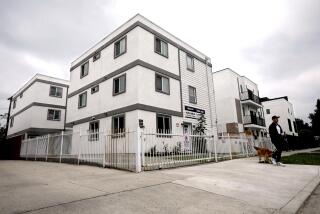Refugees Build a Haven in Long Beach : Along 10th Street, the city is known as the ‘New Phnom Penh’--the capital of the growing Cambodian community in the United States
Ell Sean had no idea what he was starting nearly 20 years ago when he bought a four-unit apartment on 10th Street in what was a run-down section of Long Beach.
Sean, one of about 125 Cambodians on U.S.-sponsored programs at local California State University campuses in the 1960s, bought the building after deciding to stay in the United States. Later, he bought the house next door and began helping some of his Cambodian colleagues from the universities to find places nearby.
Then came 1975 and the fall of Cambodia to the Communist Khmer Rouge. Sean and his friends helped the refugees who began arriving at Camp Pendleton to resettle in Long Beach. Soon the city had hundreds of Cambodians who, in turn, attracted their relatives and friends.
Heart of Community
Today, 10th Street is the heart of a Long Beach Cambodian community that has grown to between 15,000 and 25,000. The city is known among refugees as the capital of this country’s 140,000-strong Cambodian community.
“Cambodian people call Long Beach ‘New Phnom Penh,’ ” said Haing S. Ngor, a Los Angeles resident who won an Oscar for his role in “The Killing Fields,” during an interview at the Bayon Market, one of the Cambodian stores that have sprung up along 10th Street.
Ngor had dropped by the market to show it to a Cambodian-French friend, Jeanne Becavin. She commented that even in France, Cambodians speak of Long Beach.
“Everybody has Cambodian family or cousins in Long Beach,” Becavin said. “I think that these people are very lucky here, compared to Cambodians in France. Really here you have plenty of Cambodian things. This dictionary--Francais-Khmer--I’m thinking that I have to get one and take it home, because I don’t have one and I need it.”
Compared to Los Angeles’ Chinatown, Koreatown or Little Tokyo, the area around 10th Street is modest, and it remains ethnically mixed. But many Cambodian leaders are proud to have a district that can help preserve Cambodian culture and provide a geographic anchor for the community.
Described as a Slum
“Tenth Street is kind of the hub of the Cambodian community in Long Beach,” said Nil S. Hul, a merchant and spokesman for the Cambodian Business Assn. “They come to the stores mainly to buy things for their daily needs, but when they meet each other, they chat and gossip, like they do back home.”
Sean, who has sold his properties and moved to Artesia, described the area as a slum and said he feels ashamed of having helped create such a concentration of Cambodians. “To make a ghetto--I don’t like that idea at all,” Sean said.
If Sean’s role in helping create a Cambodian center was largely accidental, the role of people such as Suon Thach, owner of the Bayon Market, was purposeful.
Thach said he and three friends opened the Bayon Market in 1982 not just as a business venture but because they “wanted to build up a Khmer (Cambodian) center, a Khmer town,” that could help ease refugees’ feelings of loss and pain.
“People come here; at first they are happy because they are saved from the killing,” Thach said. “They get off the airplane and say, ‘We are in a free country now.’ But in a few more months the emotions come back. We lost our homeland. We lost our families, our parents, our brothers and sisters. It makes us very sad.”
Establishment of the Bayon Market accelerated 10th Street’s development as a lure for refugees. Other Asian stores have helped eliminate the commercial vacancies that had plagued the area. Now there are nine markets along 17 blocks that specialize in foods imported from Asia. While there are non-Asian stores in the area, most are owned by Cambodians; two others belong to Vietnamese and one is run by a Thai.
They offer essentials of Cambodian cooking--coconut milk; dried tamarind; slek krey , a vegetable that resembles tough, dry green onions; sour and hot papaya pickles; dried squid; pickled lotus root; canned mud fish and dried lime leaves.
This section of 10th Street--between Martin Luther King Jr. and Temple avenues--also has two Cambodian tailors, two shops where Cambodian-style jewelry is made and sold, a Cambodian-owned auto body shop and a Cambodian language school that draws about 60 children every Saturday.
Cambodian Businesses
Other Cambodian businesses and organizations are scattered throughout the area. A Cambodian arts group and two Cambodian-run social service organizations have facilities a few blocks away. There are four Cambodian Christian churches and a Cambodian Buddhist temple in Long Beach. Four Cambodian newspapers are published in the city, and the local cable television company recently aired a pilot program of Cambodian news and entertainment.
Community leaders believe Long Beach to be home to half of the Cambodian refugees in Los Angeles County. A significant minority of Cambodian refugees, however, are ethnically Chinese, and most of them have settled in other parts of the county, especially Echo Park and Chinatown.
Long Beach Mayor Ernie Kell said Cambodians have tended not to be very visible in city affairs, but rather to “melt into the population.”
When Cambodian Business Assn. spokesman Hul recently sought a City Council seat, “he added a plus just by running, even though he didn’t win,” Kell said. “He brought the Cambodian community to the attention of a lot of us, and I appreciate that.”
Eunice N. Sato, a former City Council member, said she believes that the 10th Street district is “very important” to many refugees because “it gives them a comfort zone,” but that some non-Cambodian residents of the area “feel they are taking over.”
“There’s some resentment on the part of those who are ignorant of the situation,” Sato said. “They don’t know they’re here because of our involvement in the war in Southeast Asia, and that they’re here with the full backing of the federal government.”
‘A Receptive City’
Long Beach “has been a receptive city,” Sato said. “Because our reception hasn’t been cold or negative, there’s been this secondary migration (from elsewhere in the United States). It’s been like a magnet attracting them to Long Beach. I think this is a credit to our city. They’ve found a place where they are comfortable.”
Community leaders confirm that thousands of Cambodians have been moving to Long Beach from other parts of the country. Smaller numbers have arrived directly from overseas.
During 1985, when 16,647 Cambodian refugees were admitted to the United States, 1,313 came directly to Los Angeles County, according to Immigration and Naturalization Service figures. In recent months, admissions from overseas have dropped sharply; only 731 Cambodian refugees were admitted to the United States from May through August this year.
Like many other Asian immigrants and refugees, Cambodians are drawn to Southern California by climate, family ties and economic opportunities. The state’s relatively generous welfare rules and its educational and training programs may also play a role.
“If they have a good job in another state, they don’t need to move here,” said Thach, who also works as a health education assistant at the Indochinese Service Center in Los Angeles. “The ones who move here are the ones who need help.” In Long Beach they have friends they can turn to for support and advice, Thach said.
Bun Ma, owner of Royal Auto Center on 10th Street, is a secondary migrant. An auto mechanic, he arrived in the United States in 1979 after walking to Thailand from Cambodia earlier that year. In 1982, when he was living in Georgia, he lost his job.
“One friend, he told me, ‘You’d better come down here. Maybe it’ll be easy to find a mechanic job,’ ” Ma said. So he made the move, found work--and early this year opened his own business.
Ma worked as a mechanic in Cambodia. But most Cambodians in Long Beach were peasants in their homeland. Many have had difficulty adjusting and remain dependent on welfare, although county officials do not count Cambodians as a separate category.
Half on Welfare
But a Los Angeles County study in 1984 indicated that about half of all Indochinese refugees in Long Beach--including Cambodians, Vietnamese and Laotians--were receiving welfare. Cambodian community leaders generally estimate welfare dependency at 50% or more.
How well refugees have adjusted depends largely on what their status was in Cambodia, according to Jim Martois, director of refugee programs at Long Beach City College.
Many--especially those who came with some education--are running businesses or have found jobs in such areas as electronic assembly, auto repair, social services or the garment industry, Martois said. Most who fled between 1975 and 1978 fall into this category and “are doing great,” he said.
But others, especially peasants who left after Vietnam occupied the country in December, 1978, are “doing lousy,” he said. Refugees receiving federal aid are required to take any job found for them, Martois said.
But, he said, many feel they have little to gain from accepting low-paying jobs, because after three years in this country, parents with children can seek welfare benefits.
$816 in Monthly Aid
Sary Vong came to the United States with his family last year after spending six years in Southeast Asian refugee camps. Vong and his family first settled in Oakland, then moved to Long Beach this spring to be closer to relatives and friends. They now live on $816 a month in federal aid while Vong and his wife, May Aut, study English in a refugee program at Long Beach City College. He and a friend each chip in $250 a month to rent a two-bedroom apartment, which is home to 10 people--themselves, their wives and three children in each family.
“In Cambodia I (was a) farmer. And I carried sacks of cotton to the factory,” Vong said. “I want to take a job soon, but I don’t understand well English, and I (have) no skill.”
Vong, 36, said he dreams of being an auto mechanic or holding another skilled job. But he has little confidence that he will find such work or anything else that will bring in as much income as the family gets from welfare.
“I save some of the money, because I think that in the future . . . it will be difficult for me to find a job (and) I think the welfare will stop,” Vong said. “I think the early days, when I get welfare, I happy. But when they cut welfare, I (will be) unhappy, because I have no skill. . . . (If) I get a job at $4 an hour, it’s not enough. It’s difficult to think about getting a job at $4 an hour. It’s not enough for my family.”
Ratha Hou, 32, an artist who once worked for the Cambodian government repairing old Buddhist sculptures, is more hopeful. Hou studies fine arts at Long Beach City College, works as a handyman and reproduces cultural artifacts--mostly copies of stonework from the great temple complex of Angkor Wat--for sale at the Bayon Market.
“I’m happy living here,” Hou said. “I hope I can reach my goal. In the future I want to open my own art shop.” Hou’s wife, Mollyny Suon, 28, said it seems “like a miracle” to be in the United States.
Although Hou and Suon hope to pass on some Cambodian culture to their three sons, they know the boys are growing up as Americans. Their oldest son, Narith, 6, who was born in a Thai refugee camp, speaks English better than Cambodian, Suon said.
“I feel proud of him,” she said. “And I think he’ll have a better life than his parents.”
More to Read
Sign up for Essential California
The most important California stories and recommendations in your inbox every morning.
You may occasionally receive promotional content from the Los Angeles Times.










